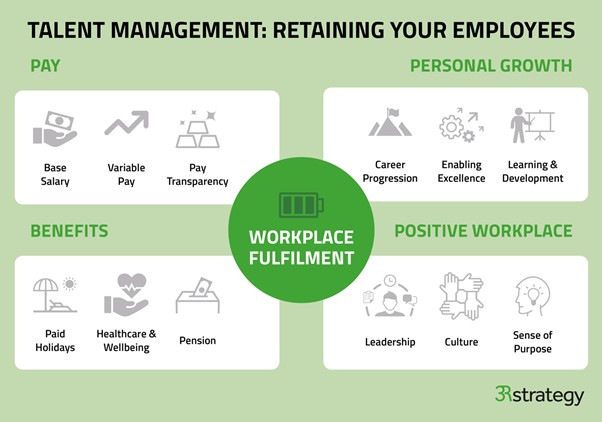Ever wonder what sets successful businesses apart from those organizations that struggle year after year?
The product or service, pricing, industry, market share, and a thousand other factors can impact business success. However, there is one area that if they don’t get right, they’ll never flourish as an organization.
Hiring and retaining quality employees.
You may believe that your customers are the most important aspect of your business, but who is serving your customers? Without a top-notch staff, your product won’t make it to market, and you won’t have any customers to serve.
With high turnover rates across industries, employers are scrambling to understand what attracts top talent, cultivates loyalty and engagement among employees, and encourages them to stick around for the long haul. If your team is experiencing dissatisfaction, low engagement and productivity, and a revolving door in your HR department, you’re probably wondering this as well.
The good news is implementing a talent management program can help businesses of all sizes and employee engagement levels find a sense of balance.
What is talent management?
Put yourself in your employee’s shoes for a moment. What is your employee experience like? What attracted you to the company in the first place? Was there something they could’ve done that would’ve made you even more eager to work there?
Now think about the onboarding process. Were you provided with the training and support you needed to succeed in your role? Are you appreciated for your unique skills and compensated appropriately? Do you believe there are adequate growth opportunities? How about the workplace culture? Do you feel comfortable voicing opinions and new ideas?
All of these questions factor into your employee’s experience and whether or not they remain engaged in their roles, or become disconnected, disheartened, and dissatisfied with their job. When this happens, they aren’t exhibiting the productivity you’re looking for, and it won’t be long before they’re planning an exit strategy.
Talent management falls into three distinct categories:
- HR processes that work together to create the best possible employee experience. We’ll discuss this more in the next section.
- Attracting, Developing, Motivating, and Retaining top talent for your organization.
- Developing High-Performing Employees
"The purpose of your talent management strategy is to attract, motivate and retain your employees,'' says Rameez Kaleem, Founder, and Director of 3R Strategy.
"No one factor, such as pay or perks, will enable you to do this. You need to consider your overall strategy to create an environment where employees can thrive and feel empowered to achieve excellence. This includes your approach to pay, benefits, creating a positive work environment, and providing people with personal and professional growth opportunities."
As a business owner, manager, or HR professional, it’s your job to provide the best possible conditions for your employees so when outside opportunities knock, they can’t help but say "no thank you, I’m happy here."

How does talent management fit under the HR umbrella?
While talent management can fall under the responsibilities of a manager or senior leader, depending on the structure of your organization, it may be carried out (at least in part) by your Human Resources department.
Why?
Human Resources is responsible for instituting workplace policies, handling interpersonal issues, and administering payroll. However, many businesses, also have a hand in the hiring process, training, mentoring, and creating the employee experience. Your HR department may shoulder the responsibility of employee engagement, performance, and company culture.
Because of this, it is essential that your HR department is considered a part of the talent management team.
Talent Management Strategy
Hopefully, you approach every aspect of your business, from marketing to sales to production to delivery and follow-up (and everything in between), with a strategy. Talent management is no different. In order to create the most positive experience for your employees, you’ll want to approach talent management with a strategic plan designed to efficiently reach your goals.
There are five steps you’ll want to work through in order to do this.
1. Identify the goals and the metrics you’ll use to measure your progress.
What do you hope to see from your Talent Management program? Are you looking to attract a higher caliber of employees? Are you experiencing extremely high turnover and looking to hang on to your top talent? Identify the talent management metrics that will allow you to track your progress and determine if you’ve reached your goal.
2. Select one or two areas to focus on (at first) before taking on a massive overhaul.
While it would be amazing to improve every aspect of your employee experience overnight, these things take time. Once you’ve determined your goals in Step 1, you’ll have a clearer picture of which area of Talent Management to tackle first. Once you’ve gotten that area optimized, you can move to the next.
3. Consider what sets you apart from the competition.
You’re used to competing for customers, but have you ever considered that you’re competing for talent as well? Just like your customers, your employees (or potential employees) have other options as well. They want to find the best fit and compensation for their skills, and you can bet they’ll be doing their homework.
Know what sets you apart from others and what makes you special. Do you offer special perks for employees? Does your culture make your employees proud to be there? Does your contribution to the community excite potential and existing team members?
Know what makes you different and don’t be afraid to communicate it to potential employees.
4. Identify the specific skills needed to grow and prosper.
Do you already have someone on your staff that can take on this responsibility? Perhaps you’ve got an HR business partner who can take the reins on a talent development program. Or perhaps, a talent manager is the first position you need to fill. Having a person dedicated to this program can help you get the most out of your existing employees, and guide the decision-making process on new hires.
5. Identify and analyze the key performance indicators.
If you can’t measure it, you can’t improve it. Get specific with the key performance indicators you’ll use to determine your success in this endeavor. Pay close attention to these numbers and if they aren’t heading in the right direction, it may be time to revisit your strategy and switch gears.
The better your strategy, the better your execution. Don’t be afraid to take some time to plan before you dive in.
Talent Management Process
Now that you understand the strategy behind talent management, how do you incorporate it into your own organization? The talent management process consists of six steps:
1. Identify your needs.
If your sink was leaking, you wouldn’t hire an electrician. Before you start posting job openings, determine what roles you need to fill and what skills are required to complete these responsibilities. Once you’ve done this, you’ll be better positioned to create the job description and post the opening.
2. Attract the right talent.
Remember you have a treasure trove of talent at your fingertips. If you have the opportunity to promote from within your company, you’ll do much more than save time on onboarding. You’ll also raise employee morale as your team now sees room for advancement within the company. If you don’t have anyone suitable, then you can look outside of the organization for a new hire.
3. Select the right talent.
This differs from company to company. You may begin with creating a shortlist of resumes, require a test to be taken, hold individual or team interviews, and ultimately leave it to the department manager or HR to make the decision. No matter how you go about it, make sure that you refer back to Step 1 and hire based on your needs.
4. Develop your employees.
This can include onboarding new employees as well as providing ongoing training for your existing employees. When you help an individual become the best employee possible.
5. Retain your employees.
You’ve worked hard to attract the best talent. Now, how do you ensure that they stay with you? Employee retention strategies can include increased pay, extra benefits or perks, rewards or gifts, promotions, etc.
6. Have an offboarding process in place.
No employee will last forever (we’ll discuss that in more detail below), but what do you do when an employee leaves? Get an understanding of what responsibilities they handle and look for a replacement based on your findings.
If the employee provided a great deal of value to the organization, ask them to train their successor so he or she is up and running before your existing employee leaves. You may also want to include an Exit Interview. You can discover a great deal of knowledge about the employee experience when you ask someone on his or her way out.
This talent management process will look a little different depending on your industry and your business model, however, this should give you a good understanding and a solid jumping-off point.
Talent Management Best Practices
There’s no need to reinvent the wheel when it comes to attracting and retaining top talent. There are a variety of talent management best practices that you can follow in order to be more successful. Some of these are:
- Have a strong employer brand. Candidates have choices when it comes to where they want to work. If you want to attract the best possible candidates, develop a strong brand as an employer.
- Have a good reputation. Of course, there are always things beyond our control, however, how the world views you is strongly based on how you show up as a company. Do what you say you’ll do and do it well.
- Encourage employee referrals. Good people know good people. Ask your existing employees to recommend job seekers they know and trust. Offer them incentives for their help and keep them apprised of how the process is going.
- Onboard and inboard properly. It’s a truly horrible feeling to join a company (or be promoted to a new role) and not be set up to succeed. Provide the training necessary for them to be their best selves in the new role.
- Provide ongoing training. Yes, they may know how to do their current job, but what are you doing to prepare them for their next role? Most employees want to progress up the career ladder and if you don’t give them the encouragement and opportunity to do this within your organization, they’ll surely go outside it.
- Create a talent pipeline. Eventually, every person will leave their role. This may be due to promotion, retirement, opportunities outside of the organization, etc. Prepare for this by identifying star performers and grooming them for promotion. When the time comes that a role is vacated, you’ll have someone waiting in the wings to step in.
- Provide performance feedback. No one likes to wonder if they’re hitting their marks and living up to their manager’s expectations. Provide regular feedback and opportunity for improvement so your employees are never in the dark about their present or future.
Your employees are truly the most important aspect of your business and without quality team members, you won’t be able to reach your goals. Implementing a talent management program in your business can help you position your organization as a sought-after employer and motivate employees to stay loyal to your organization.
Don’t be afraid to invest in your people. It will be the best investment you ever make.

